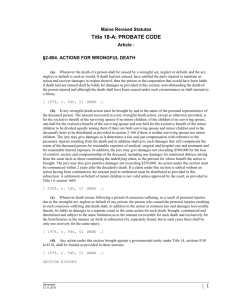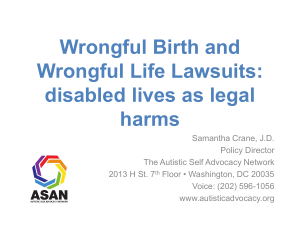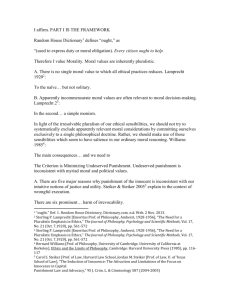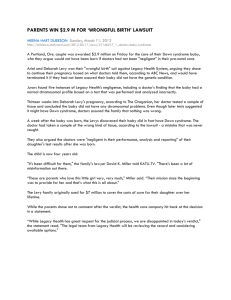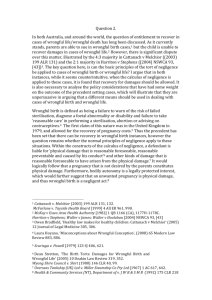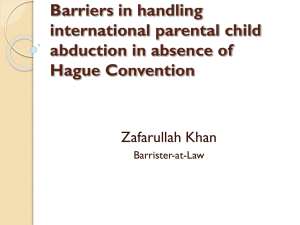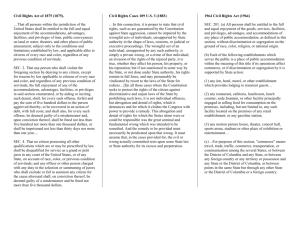Wrongful Birth & Life: Damages, Law & Policy Essay
advertisement
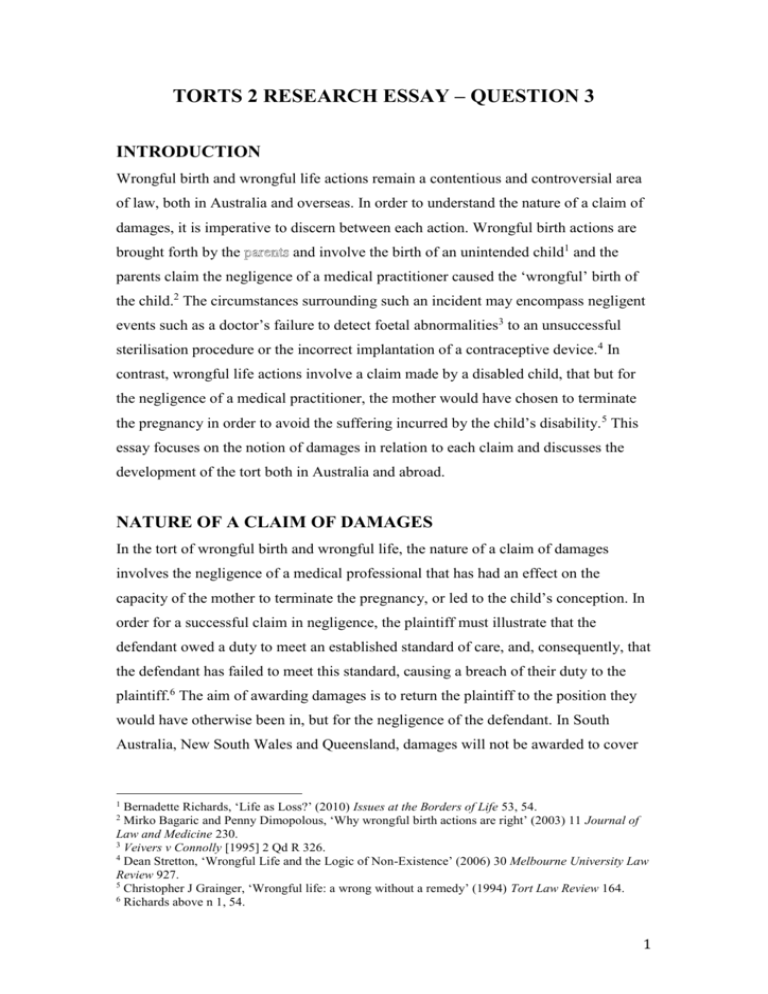
TORTS 2 RESEARCH ESSAY – QUESTION 3 INTRODUCTION Wrongful birth and wrongful life actions remain a contentious and controversial area of law, both in Australia and overseas. In order to understand the nature of a claim of damages, it is imperative to discern between each action. Wrongful birth actions are brought forth by the and involve the birth of an unintended child1 and the parents claim the negligence of a medical practitioner caused the ‘wrongful’ birth of the child.2 The circumstances surrounding such an incident may encompass negligent events such as a doctor’s failure to detect foetal abnormalities3 to an unsuccessful sterilisation procedure or the incorrect implantation of a contraceptive device.4 In contrast, wrongful life actions involve a claim made by a disabled child, that but for the negligence of a medical practitioner, the mother would have chosen to terminate the pregnancy in order to avoid the suffering incurred by the child’s disability.5 This essay focuses on the notion of damages in relation to each claim and discusses the development of the tort both in Australia and abroad. NATURE OF A CLAIM OF DAMAGES In the tort of wrongful birth and wrongful life, the nature of a claim of damages involves the negligence of a medical professional that has had an effect on the capacity of the mother to terminate the pregnancy, or led to the child’s conception. In order for a successful claim in negligence, the plaintiff must illustrate that the defendant owed a duty to meet an established standard of care, and, consequently, that the defendant has failed to meet this standard, causing a breach of their duty to the plaintiff.6 The aim of awarding damages is to return the plaintiff to the position they would have otherwise been in, but for the negligence of the defendant. In South Australia, New South Wales and Queensland, damages will not be awarded to cover Bernadette Richards, ‘Life as Loss?’ (2010) Issues at the Borders of Life 53, 54. Mirko Bagaric and Penny Dimopolous, ‘Why wrongful birth actions are right’ (2003) 11 Journal of Law and Medicine 230. 3 Veivers v Connolly [1995] 2 Qd R 326. 4 Dean Stretton, ‘Wrongful Life and the Logic of Non-Existence’ (2006) 30 Melbourne University Law Review 927. 5 Christopher J Grainger, ‘Wrongful life: a wrong without a remedy’ (1994) Tort Law Review 164. 6 Richards above n 1, 54. 1 2 1 the costs of raising a child unless that child is disabled,7 but this is not a requirement at common law. DEVELOPMENT IN AUSTRALIA AND THE INFLUENCE OF POLICY AND PRINCIPLE In Cattanach v Melchior,8 the leading authority for wrongful birth actions in Australia, the Court determined that parents should be able to recover damages to cover the costs of raising and maintaining a healthy child that was conceived following a negligently performed sterilisation procedure. The major arguments presented to challenge the Melchior’s claim were set out in the joint judgement of Justices McHugh and Gummow9 and included concerns over the potential for psychological harm on an ‘unwanted child’ and the view that children should be seen as a ‘blessing’, in addition to concerns that the healthcare profession deserves a level of immunity. The judgement also presented the notion that awarding damages to a healthy child is contrary to public policy. At the foundation of these arguments is a view that the value of life will be lessened.10 While these arguments present genuine concerns, as Kirby J highlighted ‘money, not love or the preservation of the family unit, is what is in issue.’11 In order to award damages in wrongful life claims, the Court is required to draw a comparison between living with a disability and non-existence.12 Harriton v Stephens13 and Waller v James14 both relied on public policy arguments to oppose recognising a duty of care owed to the plaintiff, with the absence of a legal consignable injury and the ‘impossibility’ of calculating damages a hindrance to the validity of the claim within the traditional tort framework.15 In Harriton, Crennan J highlighted the ‘impossible comparison’ between life with a disability and non7 See Civil Liability Act 1936 (SA) s 67(2); Civil Liability Act 2002 (NSW) ss 70, 71; Civil Liability Act 2004 (Qld) s 49 A). 8 (2003) 215 CLR 1 (‘Cattanach’). 9 Ibid 41–92 (McHugh J and Gummow J). 10 Richards, above n 1, 56. 11 Cattanach (2003) 215 CLR 1, 56 (Kirby J). 12 Rebecca Sharman, ‘Wrongful Life Actions: The Legal and Ethical Hurdles’ (2001) 9 Journal of Law and Medicine 233, 235. 13 (2006) 226 CLR 52 (‘Harriton’). 14 (2006) 226 CLR 136 (‘Waller’). 15 Gisele Kapterian, ‘Harriton, Waller and Australian negligence law: Is there a place for wrongful life?’ (2006) 13 Journal of Law and Medicine 336, 338. 2 existence and that the court is unable to practically assess ‘the actual loss or damage as claimed’,16 an argument which has been the basis for wrongful life actions to fail locally and internationally.17 While on a narrow application of tort principle and practicality it would appear that damages can not be ascertained, it should be noted that ‘approximate justice is superior to no justice at all’.18 DEVELOPMENT OVERSEAS AND THE INFLUENCE OF POLICY AND PRINCIPLE On the basis of public policy, most American states deny damages for the costs of child rearing in wrongful birth cases when the child is born healthy.19 However, there have been some occasions in the United States20 where recovery has been allowed for the costs of child-rearing but damages were balanced by the emotional benefits the parents were likely to experience as a consequence of parenthood, with the Supreme Court of Minnesota labelling this compromise ‘a mortal attempt to do justice in an imperfect world.’ Since McFarlane v Tayside Health Board,21 recovery of rearing costs in the United Kingdom has been restricted to ‘extra’ costs incurred by the parents of a disabled child, irrespective of any association between the disability and the negligent act.22 The defence in McFarlane sought to rely on the precedent established in Thake v Maurice23 that pregnancy did not constitute personal injury, a notion that ignores the pain and suffering regularly experienced throughout pregnancy and childbirth.24 Thus, mothers would be entitled to claim general damages for pain and suffering experienced as a consequence of the pregnancy. 16 Harriton (2006) 226 CLR 52 [253] 126, (Crennan J). Margaret Fordham ‘A life less ordinary – The rejection of actions for wrongful life’ (2007) 15 Torts Law Journal 123. 18 Bagaric and Dimopolous, above n 2, 234. 19 Evelyn Ellis and Brenda McGivern, ‘The wrongfulness or rightfulness of actions for wrongful life’ (2007) 15 Tort Law Review 135, 138. 20 Sherlock v Stillwater Clinic 260 NW 2d 169 (1977). 21 [2000] 2 AC 59 (‘McFarlane’). 22 Clare Lake, ‘The kid and the cash: Categorising damage in wrongful birth and wrongful pregnancy’ (2009) 17 Torts Law Journal 55. 23 [1986] QB 644 (‘Thake’). 24 Lake above n 23, 57. 17 3 Similar to its stance on wrongful birth, few American states have permitted children to succeed in wrongful life actions, with recovery of damages limited to extraordinary expenses and an exclusion of recovery for pain and suffering.25 Wrongful life actions in the United States are largely rejected, with legislation in some states prohibiting such claims.26 Despite this, the development of wrongful life actions in the United States continues, with California,27 New Jersey28 and Washington29 recognising the claims. The landmark wrongful life decision in the United Kingdom is McKay v Essex Area Health Authority,30 where the English Court of Appeal rejected the action on the basis that there was no duty for the doctor to prevent the birth and that the disability was caused by rubella, not the doctor’s negligence therefore a calculation of damages was impossible.31 The paramount importance of the sanctity of life to the law32 was also used as an argument against the recognition of wrongful life actions in McKay, with Stephenson J asserting that finding these claims to be valid would cause ‘a further inroad on the sanctity of human life which would be contrary to public policy’.33 CONCLUSION While the area of wrongful birth and wrongful life is one that needs to be approached with sensitivity, many believe that that the arguments in favour of the recognition of these actions far outweigh those raised against it,34 and that as the elements of the claim fall within the traditional tort framework it should be recognised within the Australian tort system.35 Arguments for policy and principle have been utilised to support and oppose the recognition of these claims both domestically and overseas, with wrongful birth the more established and developed of the actions. 25 Grainger, above n 5, 165. Ibid. 27 Curlender v Bio-Science Laboratory 106 Cal App 3d 811 (1980); Turpin v Sortini 643 P 2d 954 (1982). 28 Procanik v Cillo 478 A 2d 755 (1984). 29 Harbeson v Parke-Davis 656 P 2d 483 (1983). 30 [1982] 1 QB 1166 (‘McKay’). 31 Ibid 1178 (Stephenson LJ). 32 Richards above n 1, 54. 33 [1982] 1 QB 1166 at 1180. 34 Kapterian above n 17, 336. 35 Ibid. 26 4 BIBLIOGRAPHY Journal Articles Mirko Bagaric and Penny Dimopolous, ‘Why wrongful birth actions are right’ (2003) 11 Journal of Law and Medicine 230. Evelyn Ellis and Brenda McGivern, ‘The wrongfulness or rightfulness of actions for wrongful life’ (2007) 15 Tort Law Review 135. Margaret Fordham ‘A life less ordinary – The rejection of actions for wrongful life’ (2007) 15 Torts Law Journal 123. Christopher J Grainger, ‘Wrongful life: a wrong without a remedy’ (1994) Tort Law Review 164. Gisele Kapterian, ‘Harriton, Waller and Australian negligence law: Is there a place for wrongful life?’ (2006) 13 Journal of Law and Medicine 336. Clare Lake, ‘The kid and the cash: Categorising damage in wrongful birth and wrongful pregnancy’ (2009) 17 Torts Law Journal 55. Bernadette Richards, ‘Life as Loss?’ (2010) Issues at the Borders of Life 53. Dean Stretton, ‘Wrongful Life and the Logic of Non-Existence’ (2006) 30 Melbourne University Law Review 927. Rebecca Sharman, ‘Wrongful Life Actions: The Legal and Ethical Hurdles’ (2001) 9 Journal of Law and Medicine 233. Cases Cattanach v Melchior (2003) 215 CLR 1. Curlender v Bio-Science Laboratories 165 Cal Rptr 447 (Ct App, 1980). Harbeson v Parke-Davis 656 P 2d 483 (1983). 5 Harriton v Stephens (2006) 226 CLR 52 McFarlane v Tayside Health Board [2000] 2 AC 59. McKay v Essex Area Health Authority [1982] 1 QB 1166. Procanik v Cillo 478 A 2d 755 (1984) Sherlock v Stillwater Clinic 260 NW 2d 169 (1977). Thake v Maurice [1986] QB 644. Turpin v Sortini 643 P 2d 954 (1982). Veivers v Connolly [1995] 2 Qd R 326. Waller v James (2006) 226 CLR 136. Legislation Civil Liability Act 1936 (SA). Civil Liability Act 2002 (NSW). Civil Liability Act 2004 (Qld). 6
